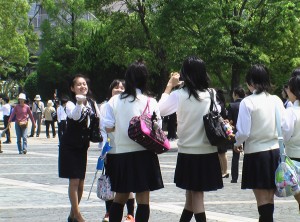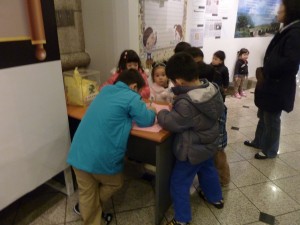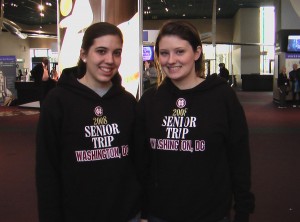Students surveyed in all three countries answered questions about the classes and preparations they engaged in before the trip. On the pages that describe student learning, you will transcriptions of the written responses to the open-ended question “List three things you learned.”
On-site teaching systems varied significantly from country to country. These findings derive from observations made on-site.
In Japan the local tour guide, commonly an employee of a bus company, predominated. Student groups were gathered into busloads on arrival, and the information about each site came to them from the local tour guide accompanying their particular bus. The guides were young, usually women, people not very different in age from the kids touring the sites.
The guides were young, usually women, people not very different in age from the kids touring the sites. The lectures were clear and focused and the relationship between guide and group appeared usually to be friendly and relaxed. Informal visual evidence suggests that there is a growing practice of sending the kids off in small groups in large cities like Kyoto and Tokyo, traveling by taxi at their own speed, with less formal or standardized teaching. However, at more distant sites like Okinawa the bus guide education system still predominates.
The lectures were clear and focused and the relationship between guide and group appeared usually to be friendly and relaxed. Informal visual evidence suggests that there is a growing practice of sending the kids off in small groups in large cities like Kyoto and Tokyo, traveling by taxi at their own speed, with less formal or standardized teaching. However, at more distant sites like Okinawa the bus guide education system still predominates.
Underpinning this pedagogy is the Japan Tourist Board, which runs a regular travel agency and also has a considerable influence on the structure of school tours. The JTB runs a university. When I first tried to learn more about it, I found it impossible to get anyone to help me learn what and who they teach at this university. These days the site even has an English language webpage. It is still quite obscure about who learns and what they learn, and whether it has anything to do with the agenda set for the school tours, or whether it is simply a management training tool.
The surveys show that Japanese parents have no say in the planning or teaching associated with these tours.
Koreans run a mixed system for their site visits. In some cases the guides are clearly associated with the bus systems. The guides are more informally dressed than their Japanese counterparts, in black slacks and orange shirts rather than smart suits and formal hats. Korea appears to have no equivalent to the Japan Tourist Bureau. The students describing the planning of their trips indicate that Korean parents, almost certainly mothers, have a meaningful say in the planning process.
Korea appears to have no equivalent to the Japan Tourist Bureau. The students describing the planning of their trips indicate that Korean parents, almost certainly mothers, have a meaningful say in the planning process.
One of the striking sights at Korean museums and memorials in Seoul is the large number of small groups visiting on weekends. These are evidently tours run by after hours Hagwan — “cram schools”. Teachers commonly are middle class mothers. Their exchanges with their students suggested intensive and directed learning quite unlike the more casual approach in both the US and Japan. The groups were often made up of younger elementary school children outside the range of this research. This was true even in the National Cemetery and War Memorial Museum, both adult and reasonably sombre sites.
Their exchanges with their students suggested intensive and directed learning quite unlike the more casual approach in both the US and Japan. The groups were often made up of younger elementary school children outside the range of this research. This was true even in the National Cemetery and War Memorial Museum, both adult and reasonably sombre sites.
In the USA, tour guides are harder to find. Most of the teaching on site seems to be in the hands of parents. Some students travel to Washington DC under the auspices of organized programs which recruit students from many schools and they do have professional guides. Most traveling groups wander the museums chaperoned by parents, who seem to have little pedagogical agenda other than keeping order. The groups are identifiable if they have matching tee-shirts,
Most traveling groups wander the museums chaperoned by parents, who seem to have little pedagogical agenda other than keeping order. The groups are identifiable if they have matching tee-shirts, but generally speaking American students on site do not function as a large coordinated group except when they gather in the cafeteria.
but generally speaking American students on site do not function as a large coordinated group except when they gather in the cafeteria.
In all three countries the education offers a mixture of formal lectures and free time to wander. Generally in Japan the students move freely inside museums and often receiving their lectures in the central memorial plaza or some outside space.

No Comments so far ↓
There are no comments yet...Kick things off by filling out the form below.